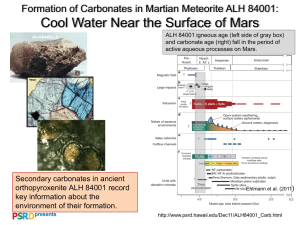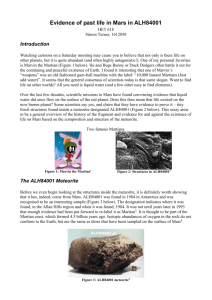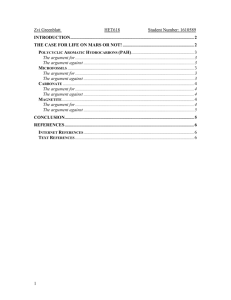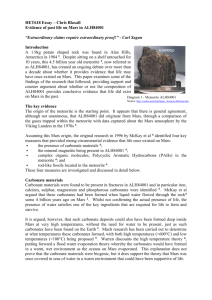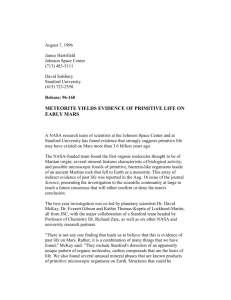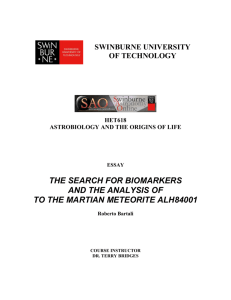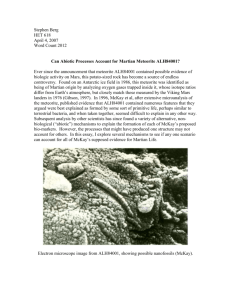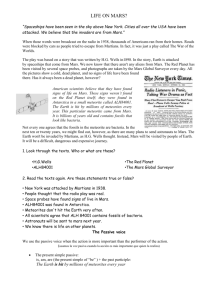Essay-HET618
advertisement
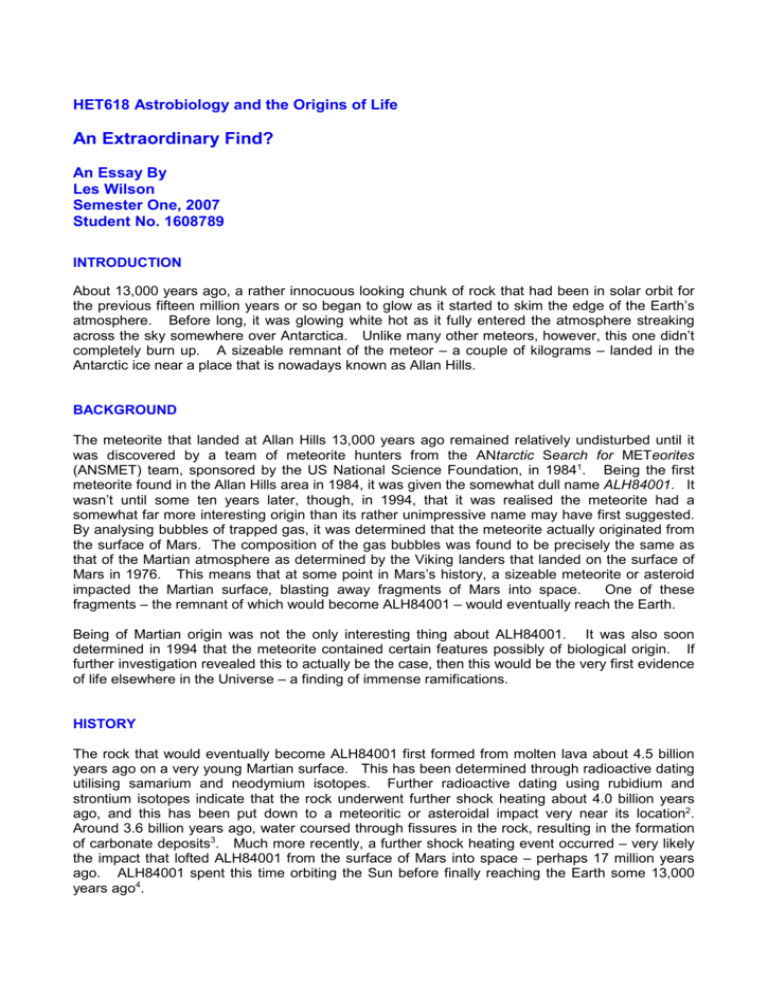
HET618 Astrobiology and the Origins of Life An Extraordinary Find? An Essay By Les Wilson Semester One, 2007 Student No. 1608789 INTRODUCTION About 13,000 years ago, a rather innocuous looking chunk of rock that had been in solar orbit for the previous fifteen million years or so began to glow as it started to skim the edge of the Earth’s atmosphere. Before long, it was glowing white hot as it fully entered the atmosphere streaking across the sky somewhere over Antarctica. Unlike many other meteors, however, this one didn’t completely burn up. A sizeable remnant of the meteor – a couple of kilograms – landed in the Antarctic ice near a place that is nowadays known as Allan Hills. BACKGROUND The meteorite that landed at Allan Hills 13,000 years ago remained relatively undisturbed until it was discovered by a team of meteorite hunters from the ANtarctic Search for METeorites (ANSMET) team, sponsored by the US National Science Foundation, in 19841. Being the first meteorite found in the Allan Hills area in 1984, it was given the somewhat dull name ALH84001. It wasn’t until some ten years later, though, in 1994, that it was realised the meteorite had a somewhat far more interesting origin than its rather unimpressive name may have first suggested. By analysing bubbles of trapped gas, it was determined that the meteorite actually originated from the surface of Mars. The composition of the gas bubbles was found to be precisely the same as that of the Martian atmosphere as determined by the Viking landers that landed on the surface of Mars in 1976. This means that at some point in Mars’s history, a sizeable meteorite or asteroid impacted the Martian surface, blasting away fragments of Mars into space. One of these fragments – the remnant of which would become ALH84001 – would eventually reach the Earth. Being of Martian origin was not the only interesting thing about ALH84001. It was also soon determined in 1994 that the meteorite contained certain features possibly of biological origin. If further investigation revealed this to actually be the case, then this would be the very first evidence of life elsewhere in the Universe – a finding of immense ramifications. HISTORY The rock that would eventually become ALH84001 first formed from molten lava about 4.5 billion years ago on a very young Martian surface. This has been determined through radioactive dating utilising samarium and neodymium isotopes. Further radioactive dating using rubidium and strontium isotopes indicate that the rock underwent further shock heating about 4.0 billion years ago, and this has been put down to a meteoritic or asteroidal impact very near its location2. Around 3.6 billion years ago, water coursed through fissures in the rock, resulting in the formation of carbonate deposits3. Much more recently, a further shock heating event occurred – very likely the impact that lofted ALH84001 from the surface of Mars into space – perhaps 17 million years ago. ALH84001 spent this time orbiting the Sun before finally reaching the Earth some 13,000 years ago4. Figure 1. ALH84001. The Allan Hills meteorite found in 1984 and determined to be of Martian origin in 1994a. DOES ALH84001 CONTAIN FEATURES OF BIOLOGICAL ORIGIN? The main features5 of ALH84001 indicating possible biological origin are: (a) evidence of water having penetrated fissures within ALH84001 with deposits of calcium, magnesium and iron carbonates found within those fissures. These features resemble, at least morphologically, similar features found on Earth known to be of biological origin; (b) the low-level presence of organic compounds, including amino acids and polycyclic aromatic hydrocarbons (PAHs), that could be associated with biogenic activity; (c) evidence of tiny grains of magnetite morphologically very similar to those which are deposited biogenically on Earth; and (d) the presence of tiny ovoid features ranging in size from 20 to 100 nanometres that could be the fossilised remains of so-called nanobacteria, the existence on Earth for which is still a controversial subject. Furthermore, these four features do seem to be associated with one another in that they are found in close proximity within the meteorite. Perhaps the greatest champions for the evidence of past Martian life in ALH84001 are David McKay and Everett Gibson Jr., both of the Johnson Space Centre in Houston Texas, along with their various associates. Whilst they do concede that it is possible for each of the features to be produced inorganically, their contention is that the four features being in such close spatial proximity to each other is strong evidence of a biological origin. So, what is the evidence for and against evidence of Martian life in ALH84001? compelling enough to state categorically that life once existed on Mars? Is the evidence CARBONATE DEPOSITS The carbonate deposits found within the fissures found in ALH84001 are very similar to features found in Earth rocks which are often (though not always) of biological origin6. However, hydrothermal water with dissolved carbonates of inorganic origin could easily have passed through the fissures in the meteorite at some point while it was still on the surface of Mars, leaving behind the carbonate deposits7. Figure 2. Carbonate Deposits in ALH84001. Close-up microscopic view of carbonate deposits found within ALH84001. Measurements of carbon isotope (13C:12C) ratios (known as 13C) of carbon compounds within the meteorite also point towards an inorganic origin. Positive values for 13C imply an inorganic origin, whereas any negative values could imply a biological origin (though not necessarily). In a study conducted in 1999 (Becker, 1999), several 13C values were determined8. One value of 13C of +42o/oo for the carbonate deposits is well outside those for even terrestrial inorganically deposited carbonates and confirms a uniquely extraterrestrial inorganic origin. An average 13C value for the organic matter associated with the carbonate deposits of -26o/oo is attributed to terrestrial contamination, and a 13C value of -15o/oo for the meteorite bulk matrix is consistent with carbonaceous chondrite 13C values. This implies both an inorganic origin and that a cometary or meteoritic impact had previously occurred in the site from which ALH84001 originated. This does circumstantially correlate with the possible impact that occurred near the original site of ALH84001 some 4.0 billion years ago. ORGANIC COMPOUNDS According to McKay, Gibson et al, the contentious organic compounds in ALH84001 are polycyclic aromatic hydrocarbons (PAHs) and amino acids – both of which can be associated (but not always) with biogenic activity. Most PAHs on Earth result from biological sources, but they can also have a non-biological origin such as carbonaceous meteorites9. Furthermore, at least some of the PAHs in ALH84001 may have originated from terrestrial contamination, since it has been shown that Antarctic ice does contain small quantities of PAHs. With ALH84001 having been lodged in the Antarctic ice sheet for 13,000 years, and with Antarctic meltwater having been shown, through 14C analysis, to have infiltrated the meteorite, contamination by terrestrial PAHs is highly likely10. McKay and Gibson’s counter to this is that PAHs are found in ALH84001 where Antarctic meltwater could not have reached, and these are further associated with the carbonate deposits implying the same biogenic origin11. However, further work by Becker (1999) indicates that PAHs could possibly leech well inside the meteorite through the action of organic matter present rather than through water action12. Furthermore, work by Treiman (2003) has shown that PAHs can be produced non-biogenically with magnetite acting as a catalyst. This could provide a non-biogenic explanation as to why there are PAHs associated with the carbonate deposits13. The presence of amino acids in ALH84001 have been shown to be almost certainly due to terrestrial contamination14. MAGNETITE GRAINS Figure 3. Magnetite Grains in ALH84001. Microscopic view of grains of magnetite found in ALH84001. Certain types of bacteria on Earth known as magnetotactic bacteria are known to leave grain deposits of magnetite crystals and these are morphologically very similar to those found in ALH84001. It is McKay and Gibson’s contention that these were deposited by Martian magnetotactic bacteria. Whilst it is difficult to produce magnetite grains inorganically15, it is not impossible. Indeed experiments by Cohn (2006) have shown that magnetite grains of less than 100 nm in size can be consistently produced inorganically through the shock heating of iron-rich carbonate granules in a carbon dioxide environment16. Furthermore, terrestrial magnetotactic bacteria leave magnetite grains of consistent size, yet those found in ALH84001 are all different in size17. McKay and Gibson’s counter to this is that there must have been different-sized Martian magnetotactic bacteria present in ALH84001. NANOBACTERIA FOSSILS? Figure 4. Nanobacteria Fossils? Electron micrograph view of rod-like and ovoid-shaped features resembling terrestrial bacteria, though a hundred times smaller. McKay and Gibson further contend that the ovoid nanostructures found in ALH84001 are the fossilised remnants of nanobacteria – the existence on Earth for which is still a controversial claim. The main argument against nanobacteria on Mars is that they are simply too tiny to contain sufficient cell machinery to carry out life processes. They are on the order of one hundredth the size of terrestrial bacteria. Even if terrestrial nanobacteria really do exist, they would live in environments such as human blood, rich in organic materials and obviating the need for a full suite of cell machinery. On Mars, however, where organic materials have always been very scarce, full cell machinery would have to have been a must, and so it is hard to imagine how Martian nanobacteria could ever have made a living. Such nanostructures can also be produced non-biologically in the form of mineral depositions. Furthermore, no evidence of cellular structure, cellular growth, reproduction, local clustering and other such features of terrestrial bacteria can be found18. There is also a possibility that the ovoid shapes may even originate from the sample treatment process the samples underwent prior to electron microscopy19. CONCLUSION It can be shown that for each of the four main features indicative of possible life in ALH84001, a non-biogenic origin is possible. The contention that an inorganic origin for all four features taken together is highly unlikely and so therefore must be due to biologic activity, is still not evidence enough of past life on Mars. The extraordinary claim for past life on Mars must be backed up by extraordinary evidence – and unfortunately no such extraordinary evidence exists in ALH84001. Everett Gibson has stated that the evidence for life in ALH84001 would pass the normal criteria acceptable for past life and microfossils on Earth20. But this is the whole point. Any claim for life elsewhere must necessarily pass more stringent additional criteria than those for life on Earth. After all, every time we examine life on Earth, we don’t have to reprove that life exists here. Carbonate deposits can be produced inorganically by precipitation from hydrothermal water. Magnetite grains can be produced by the shock heating of carbonate granules, and it is highly likely that these magnetite grains may have catalysed the production of PAHs found associated with the carbonate deposits. Different-sized magnetite grains having been produced by many different-sized Martian magnetotactic bacteria does stretch the imagination somewhat too far perhaps. Finally, the tiny ovoid nanostructures were probably deposited minerologically and, while being morphologically very similar to fossils of terrestrial bacteria (though far smaller), they do not display the normal features of such bacteria such as clustering, growth or reproduction. The evidence for Martian past life in ALH84001 is, at best, circumstantial. What is needed is evidence that provides an overwhelming substantiation for such an extraordinary claim. Unfortunately, it is very unlikely that this will ever be provided by ALH84001. REFERENCES: 1 2 3 4 5 6 7 8 9 10 http://www.lpi.usra.edu/lpi/meteorites/The_Meteorite.html technicalities http://www.lpi.usra.edu/lpi/meteorites/The_Meteorite.html loc cit. http://www-curator.jsc.nasa.gov/antmet/marsmets/posslife.cfm Knoll, A.H., ‘A Martian Chronicle’, The Sciences, July/August, 1998 Treiman, A.H. ‘Submicron Magnetite Grains and Carbon Compounds in Martian Meteorite ALH84001: Inorganic, Abiotic Formation by Shock and Thermal Metamorphism’, Astrobiology Journal No.3, 2003 pp369-392 Becker, L., Popp, B. et al, ‘The Origin of Organic Matter in the Martian Meteorite ALH84001’, earth and Planetary Science Letters 167 (1999) 71-79 Knoll, op cit. loc cit. 11 12 13 14 15 16 17 18 19 20 McKay, D.S., Gibson, E.K. Jr., et al. ‘Search for Past Life on Mars: Possible Relic Biogenic Activity in Martian Meteorite ALH84001,’ Science No. 273, 1996, pp924-930 Becker, op cit. Treiman, op cit. Becker, op cit. Kirschvink, Joseph L., Kobayashi, Atsuko, ‘Magnetofossils and ALH84001: Was the Requiem For Life on Mars Premature?’ Abstracts from the Astrobiology Science Conference 2004, International Journal of Astrobiology, Supplement, 2004 Cohn, A. ‘Formation of Magnetite Nanoparticles by Thermal Decomposition of Iron Bearing Carbonates: Implications for the Evidence of Fossil Life on Mars’, ‘Materials’ Journal, NNIN REU 2006 Research Accomplishments, pp58-59 Knoll, op cit. http://www.lpi.usra.edu/lpi/meteorites/life.htm Knoll, op cit. Gibson, E.K. Jr., McKay, D.S., et al. ‘Life on Mars: Evaluation of the Evidence Within Martian Meteorites ALH84001, Nakhla, and Shergotty,’ Precambrian Research No. 106, 2001 pp15-34 IMAGE CREDITS Figure 1. Figure 2. Figure 3. Figure 4. http://www.lpi.usra.edu/lpi/meteorites/Themeteorite.gif http://curator.jsc.nasa.gov/curator/antmet/marsmets/alh84001/ALH84001Carbonates.htm http://nai.arc.nasa.gov/news_stories/news_detail.cfm?article=old/magnetite_ chains.htm http://www.lpi.usra.edu/lpi/meteorites/Photomicrograph.gif
